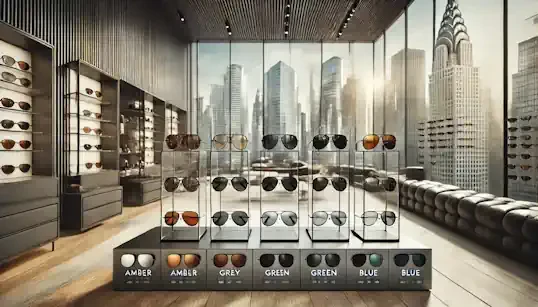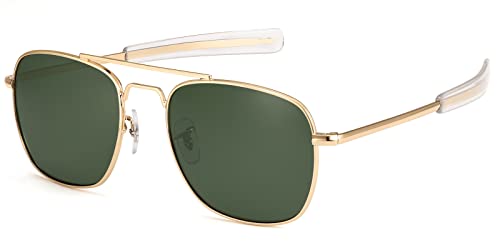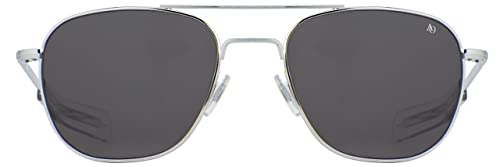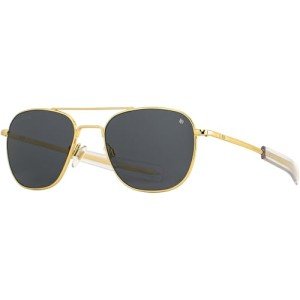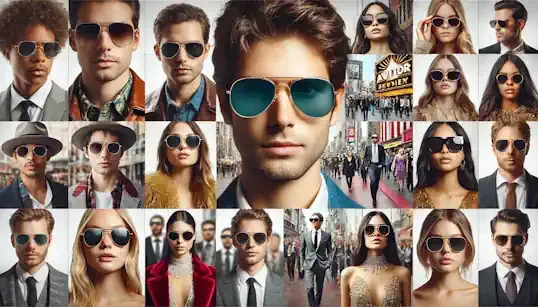Aviator sunglasses: instantly recognizable, effortlessly cool, a timeless symbol of style and adventure. From the silver screen to the sun-drenched streets, their iconic teardrop shape has graced faces for generations. But beyond the distinctive frame lies a crucial element often overlooked, yet profoundly impactful: the lens tint. While the shape might be what initially catches the eye, the color of the lens is what truly shapes your vision, comfort, and even your perception of the world around you when wearing aviators. Lens tint isn’t merely a cosmetic choice; it’s a powerful tool that can dramatically alter how you see in different lighting conditions, enhance visual clarity for specific activities, and, of course, contribute significantly to the overall stylistic statement your aviator sunglasses make. Choosing the right lens tint is about far more than just matching your outfit; it’s about optimizing your visual experience, protecting your eyes, and expressing your personal style with intention. This guide aims to demystify the world of aviator lens tints, diving deep into the secrets behind each color. We’ll explore not only the practical vision benefits offered by various tints but also their subtle stylistic connotations and aesthetic impact. Whether you're a seasoned aviator aficionado or simply seeking your first pair, understanding the nuances of lens tints will empower you to make informed choices, ensuring your sunglasses are not just a fashion accessory, but a functional and stylish extension of your vision and personality.
To truly appreciate the impact of lens tint, it’s helpful to understand the basic science at play. Spectacle tints work by selectively absorbing and filtering wavelengths of light as they pass through the lens material. Think of sunlight as a spectrum of colors, each with a different wavelength. When light hits a tinted lens, certain wavelengths are absorbed, reducing the amount of light that reaches your eyes. Different lens tints are formulated to absorb different parts of this light spectrum, leading to varied visual effects. Light transmission, often abbreviated as VLT, is a crucial concept. VLT refers to the percentage of visible light that passes through the lens and reaches your eye. A lens with a low VLT (like a very dark tint) transmits less light, making it ideal for bright sunlight. Conversely, a lens with a high VLT (like a lightly tinted or clear lens) transmits more light and is better suited for low-light conditions. Darker tints, while effective at reducing overall light intensity, can sometimes impact color perception, making colors appear muted or slightly distorted. This is where the concept of contrast enhancement comes into play. Certain lens tints are specifically designed to enhance contrast, particularly in specific lighting conditions. For instance, brown and amber lenses excel at filtering out blue light, which is known to scatter and create haze, especially in overcast or hazy conditions. By blocking blue light, these tints can sharpen visual acuity and improve depth perception, making objects appear more defined and distinct. Color perception itself is directly affected by lens tints. Neutral tints like grey are designed to minimize color distortion, allowing you to see colors as accurately as possible, simply with reduced brightness. Other tints, however, intentionally alter color perception to achieve specific visual effects. For example, yellow lenses enhance contrast but also significantly alter color perception, making the world appear warmer and brighter, especially in low light. It’s crucial to remember that while lens tint color plays a significant role in visual performance and style, it is entirely separate from UV protection. UV protection is an invisible coating or material incorporated into the lens to block harmful ultraviolet (UV) radiation from the sun. Regardless of the tint color, all high-quality sunglasses, including aviators, should offer 100% protection against both UVA and UVB rays. Lens tint primarily affects visible light transmission, contrast, and color perception, while UV protection safeguards your eyes from invisible, harmful radiation.
Now, let's delve into the fascinating color palette of aviator lens tints, exploring the unique visual benefits and stylistic nuances of each hue. Grey lenses are the neutral backbone of the sunglass world, offering a balanced and versatile visual experience. Their primary vision benefit lies in their even reduction of light across the entire color spectrum. This means grey lenses reduce brightness without significantly altering color perception, allowing you to see the world in true colors, just in a slightly dimmed and more comfortable way. This neutrality makes them ideal for bright sunlight and general-purpose use, where accurate color vision is important, such as driving, walking around town, or simply relaxing outdoors. By reducing overall light intensity, grey lenses minimize eye strain and fatigue in bright conditions, making them comfortable for extended wear. Stylistically, grey lenses are the epitome of classic versatility. They complement virtually all skin tones and personal styles, seamlessly transitioning from casual to formal settings. Grey tinted aviators exude an understated sophistication and timeless appeal, perfectly capturing the traditional essence of the aviator aesthetic. Whether paired with jeans and a t-shirt for a relaxed weekend look or a sharp suit for a business meeting, grey aviators lend an air of cool confidence and effortless style. Think of iconic figures throughout history, from pilots to movie stars, often sporting grey lens aviators – a testament to their enduring and universal appeal.
Brown or amber lenses step away from pure neutrality, offering a warmer visual experience with enhanced contrast and depth perception. Their key vision benefit stems from their ability to filter out blue light, a component of the light spectrum that tends to scatter and create haze, particularly in variable or overcast conditions. By selectively blocking blue light, brown and amber lenses sharpen visual acuity, improve contrast, and enhance depth perception, making them exceptionally useful in hazy, foggy, or partly cloudy weather. This makes them a popular choice for activities like driving, fishing, and general outdoor pursuits where clear, sharp vision is paramount, even when the lighting isn't perfectly bright and sunny. Brown and amber tints also tend to be comfortable for longer wear in moderately bright light, providing a soothing visual experience without excessive dimming. In terms of style, brown and amber lenses offer a warmer, slightly richer aesthetic compared to the cool neutrality of grey. They tend to complement warmer skin tones and earth-toned outfits particularly well, adding a touch of warmth and depth to your overall look. While still versatile, brown and amber lenses offer a slightly more distinctive and less stark look than grey, adding a subtle touch of personality to your aviator style. They can evoke a vintage-inspired feel or complement a casual-chic ensemble, lending a touch of warmth and sophistication. Imagine brown lens aviators paired with a leather jacket and chinos, or a flowing summer dress in earthy tones – a look that’s both stylish and visually comfortable.
Green lenses strike a balanced middle ground, offering a compelling combination of good color perception and enhanced contrast. Their vision benefits are rooted in their ability to reduce glare while still providing relatively accurate color vision. Green tints offer a good level of overall light reduction, making them suitable for general-purpose use, especially in variable light conditions where the intensity of sunlight fluctuates throughout the day. While they maintain good color accuracy, green lenses can also enhance contrast slightly more than grey lenses in certain lighting situations, offering a subtle boost to visual sharpness. Stylistically, green lenses are another classic and highly versatile option, offering a cool and balanced aesthetic. Often associated with a sporty or outdoor-oriented style, green aviators project an image of active sophistication and understated cool. They tend to work well with a wide range of skin tones and hair colors, making them a universally flattering choice. Green lens aviators can seamlessly transition from active wear and casual outfits to slightly more dressed-up ensembles, adding a touch of sporty chic to any look. Picture green lens aviators paired with athletic wear for an outdoor run or with a crisp white shirt and tailored shorts for a stylishly casual summer afternoon – a look that’s both functional and effortlessly cool.
Yellow and orange lenses venture into a different visual territory, prioritizing low-light performance and extreme contrast boosting. Their vision benefits are most pronounced in low-light conditions. These tints excel at significantly enhancing contrast and depth perception when ambient light is reduced, such as on overcast days, in fog, or even indoors in dimly lit environments. They work by filtering out blue light even more aggressively than brown or amber lenses, making objects appear sharper, brighter, and more defined in hazy or foggy conditions. However, it's crucial to understand that yellow and orange lenses are not suitable for bright sunlight. They are specifically designed for low-light conditions, overcast days, fog, or even indoor use in certain situations (like shooting sports where target clarity is paramount). Wearing them in bright sunlight can lead to discomfort and insufficient light reduction. Stylistically, yellow and orange lenses are bold and distinctive choices, far less traditional for everyday aviator wear. They make a strong style statement, projecting a retro, sporty, or even slightly edgy vibe. While not universally flattering in the same way as neutral tints, yellow and orange lenses can be intentionally used to create a specific fashion statement or enhance a particular look. They can evoke a retro-futuristic aesthetic or amplify a sporty, high-energy ensemble. Imagine yellow lens aviators paired with ski gear in flat light conditions, or with a retro-inspired outfit for a vintage car rally – a look that’s both visually functional and undeniably attention-grabbing.
Rose, red, and pink lenses introduce a touch of warmth and fashion-forward flair, offering a unique blend of enhanced contrast and visual comfort. Their vision benefits are particularly notable in their excellent contrast enhancement, especially against green and blue backgrounds. This makes them highly effective at improving visual depth and road visibility, particularly in partly cloudy conditions or when driving. Rose, red, and pink tints are also often praised for their visual comfort. They can be soothing on the eyes and reduce eye strain for some individuals, making them comfortable for extended wear, particularly in variable light conditions. They are a good choice for activities like driving, skiing, and water sports where light conditions can change rapidly and enhanced contrast is beneficial. Stylistically, rose, red, and pink lenses are undeniably fashion-forward and trendy choices, adding a noticeable and less traditional twist to the classic aviator shape. They project a sense of individuality and style consciousness, standing out from more conventional tints. These warmer hues can add a unique and playful touch to aviator sunglasses, injecting a pop of color into your look. Rose, red, and pink lenses tend to complement cooler skin tones and pair well with pastel or neutral-colored outfits, adding a subtle yet stylish contrast. Envision rose lens aviators paired with a cream-colored summer dress, or with a grey suit to add a touch of unexpected warmth and personality – a look that's both fashionable and visually appealing.
Blue, mirrored, and silver lenses occupy a stylistic niche, often prioritizing fashion appeal and specific glare reduction capabilities, with some visual caveats to consider. Their vision benefits primarily lie in their ability to effectively reduce glare, especially glare reflected from water and snow. Some blue tints are also marketed as reducing haze, although their haze-reducing capabilities are generally less pronounced than those of brown or amber lenses. Mirrored and silver coatings primarily enhance style and reduce light transmission, making them beneficial in extremely bright conditions, especially at high altitudes or near reflective surfaces. Stylistically, blue, mirrored, and silver lenses are undeniably stylish and often associated with a modern, sporty, or even edgy aesthetic. Mirrored lenses, in particular, make a strong style statement due to their highly reflective surfaces, creating a visually striking and contemporary look. Blue tints can range from subtle washes of color to bold, vibrant hues, offering a spectrum of stylistic options to match different tastes and outfits. While versatile, mirrored lenses are often perceived as more casual and overtly fashionable than traditional tints. Imagine blue mirrored aviators paired with beachwear for a day by the ocean, or with sporty athleisure wear for a modern, active look. Silver lenses can add a sleek, futuristic touch to contemporary outfits. However, it's important to acknowledge the caveats associated with blue and mirrored lenses. Blue tints can sometimes distort colors more significantly than neutral tints, potentially affecting color accuracy. Mirrored coatings, while stylish and effective at reducing light, can be prone to scratches, requiring careful handling. Furthermore, blue tints may not be ideal for all light conditions and may not enhance contrast as effectively as other tints in certain situations, particularly compared to contrast-enhancing tints like brown or amber in hazy or overcast conditions. Therefore, while blue, mirrored, and silver lenses excel in style and glare reduction, their visual performance may be more specialized and less universally beneficial compared to neutral or contrast-enhancing tints.
Beyond the spectrum of colors, several other lens features significantly impact the performance and suitability of aviator sunglasses. Polarization is a crucial feature to consider, especially for activities like driving, boating, or skiing. Polarized lenses are specially designed to reduce glare from horizontal surfaces such as water, roads, and snow. This is achieved through a special filter that blocks horizontally polarized light waves, which are the primary source of distracting glare. Polarization significantly enhances visual clarity, reduces eye strain caused by glare, and improves depth perception in bright, reflective environments. Polarization is highly beneficial in aviator sunglasses, particularly for driving in sunny conditions or engaging in water sports, making vision more comfortable and safer. Importantly, polarization can be incorporated into lenses of various tints, combining the benefits of glare reduction with the specific visual advantages of different lens colors. Mirror coatings, as briefly mentioned, are another feature that primarily enhances style and reduces light intensity, particularly in extremely bright conditions. These coatings are applied to the outer surface of the lens and reflect a significant portion of incoming light, further reducing glare and brightness. While primarily a style feature, mirror coatings can be functionally beneficial in very bright environments like high-altitude mountaineering or snow sports, offering an extra layer of light protection. Gradient lenses, characterized by a tint that is darker at the top and gradually lightens towards the bottom, offer unique advantages for specific uses. This design provides shading from overhead sunlight while allowing clearer vision through the lower portion of the lens. Gradient tints are particularly beneficial for driving, as they shield your eyes from the bright sky while allowing a clearer view of the dashboard and road ahead. They are also well-suited for general everyday wear, providing comfortable vision in varied lighting conditions. Gradient tints are available in various colors, allowing you to combine the stylistic and visual benefits of color tints with the practical advantages of a gradient design. Photochromic lenses, also known as Transitions lenses, represent a different approach to lens tinting, offering dynamic adaptation to changing light conditions. These lenses automatically adjust their tint darkness based on the level of UV light they are exposed to, becoming darker in bright sunlight and lighter in dimmer environments. Photochromic lenses offer convenience and versatility, eliminating the need to switch between sunglasses and regular glasses in changing light conditions. While less common in classic aviator styles, photochromic technology is increasingly being incorporated into aviator frames, offering a practical and adaptive option. Photochromic lenses are typically available in grey and brown tints, providing neutral or contrast-enhancing visual experiences that adapt to varying light levels.
Choosing your perfect aviator lens tint is a personal journey, balancing visual needs with stylistic preferences. Begin by assessing your primary use and the activities you anticipate using your aviator sunglasses for most frequently. Are they primarily for driving, everyday wear around town, outdoor sports, or specific activities like boating or skiing? Your primary activities will heavily influence the ideal tint characteristics. Next, consider the typical lighting conditions you encounter most often. Do you primarily spend time in bright sunlight, overcast environments, variable light conditions, or even low-light settings? Understanding your typical lighting environment will help you narrow down tint options that excel in those specific conditions. Think about your specific visual needs and priorities. Do you prioritize accurate color perception, enhanced contrast, effective glare reduction, or improved vision in low-light conditions? Identifying your visual priorities will guide you towards tints designed to address those needs. Reflect on your personal style and the overall aesthetic you wish to achieve with your aviator sunglasses. Do you prefer a classic and understated look, a modern and sporty vibe, a fashionable and trendy statement, or a vintage-inspired aesthetic? Your personal style preferences will guide your color choices to complement your overall look and personality. Whenever possible, engage in trial and error. If possible, visit an eyewear store and try on aviator sunglasses with different lens tints in various lighting conditions. Experiencing the visual differences firsthand will provide invaluable insight into which tint provides the best vision and comfort for your individual eyes. Finally, don't hesitate to consult with eyewear professionals. Opticians and eyewear specialists can offer personalized recommendations based on your specific visual needs, lifestyle, and style preferences. They can provide expert advice and help you navigate the nuances of lens tints to ensure you select the perfect aviator sunglasses for your individual requirements. By thoughtfully considering these practical steps and aligning your visual needs with your stylistic desires, you can confidently navigate the world of lens tints and unlock the full potential of your aviator sunglasses.
In the realm of aviator sunglasses, the lens tint is far more than a mere color choice; it’s a critical element that shapes both your vision and your style. From the neutral clarity of grey to the contrast-boosting warmth of brown, the vibrant pop of rose, and the specialized performance of yellow, each tint offers a unique visual experience and stylistic expression. Choosing the perfect aviator lens tint is about understanding your individual needs, considering your lifestyle and typical lighting conditions, and consciously balancing functional visual benefits with personal aesthetic preferences. The “perfect” tint isn’t a universal concept; it’s a personalized choice, a harmonious blend of visual optimization and self-expression. By arming yourself with the knowledge of lens tint secrets, you’re empowered to make informed decisions, transforming your aviator sunglasses from a simple accessory into a powerful tool that enhances both how you see the world and how the world sees you. Embrace the art of aviator lens tint selection, see clearly, look sharp, and step out into the world with confidence, knowing your sunglasses are not just shielding your eyes, but also perfectly reflecting your individual style and visual needs.
